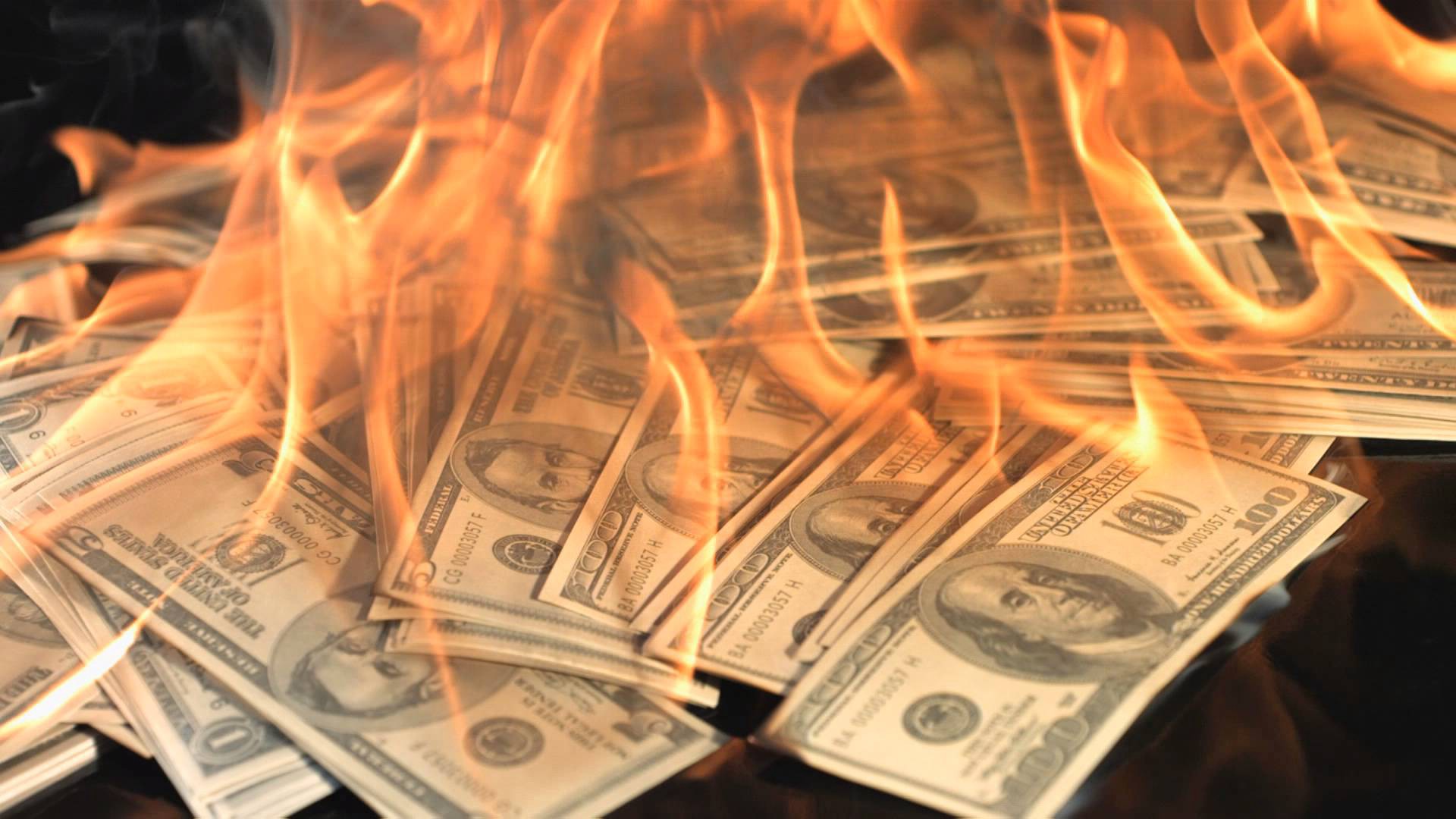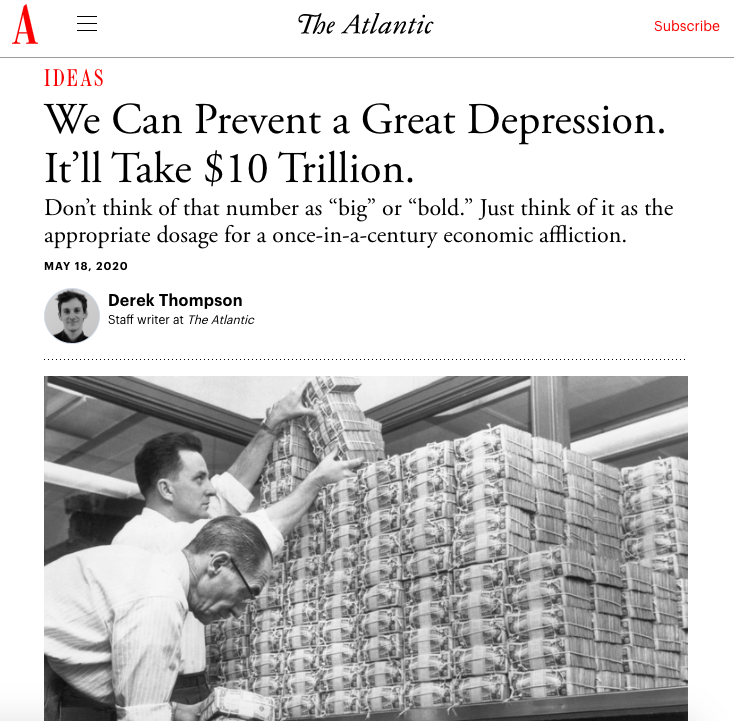The Atlantic is giving us a number: $10 trillion.
The number is very wrong, but it’s nice that they are even trying to put a tab on the damage of this hoax. Most of the media is avoiding this subject entirely, because the conclusions are absolutely apocalyptic.
It would be great if they could explain whether or not this will lead to a global dumping of the dollar as a reserve currency, as non-hoaxing countries figure out that it is becoming monopoly money. Russia has already dumped 96% of its US debt holdings, but they are not a huge financial player. If China were to take this same line, you’d have a freefall collapse.
Last week, House Democrats unveiled their latest pandemic-relief package. The bill combines aid for families, a bailout for struggling cities and states, and additional funds for testing, tracing, and hospitals. The price tag is about $3 trillion—and it comes just weeks after the president signed an economic-relief package worth about $2 trillion.
Republicans have assailed the bill as a profligate wish list. Even Americans who are suffering from the health and economic ravages of the pandemic may feel a bit stunned by the dollar amount. Does the government really have to spend $5 trillion in three months? Can the United States afford to dump such unfathomable amounts of money into the economy?
The answers to those questions are yes and absolutely yes.
Small-business activity has plunged nationwide by nearly 50 percent. Hundreds of thousands of companies have already failed. Big retailers such as J.Crew and Neiman Marcus have filed for bankruptcy, while others, including Macy’s, are teetering. By some measures, scarcely one-third of Americans say they are working. Next month’s jobs report will likely show that, for the first time since World War II, a majority of Americans aren’t officially employed.
“The scope and speed of this downturn are without modern precedent,” Federal Reserve Chair Jerome Powell said on Wednesday. “Additional fiscal support could be costly but worth it if it helps avoid long-term economic damage and leaves us with a stronger recovery.”
To understand why the U.S. needs additional fiscal support, let’s review where we stand on government assistance.
In March, the U.S. passed the CARES Act, which helped families and small businesses in a variety of ways. Most famous, perhaps, were the $1,200 checks for tens of millions of families. Unemployment Insurance got a $600-a-week bump. Congress also created the Paycheck Protection Program to accelerate the distribution of emergency cash to small and medium-size businesses.
While the CARES Act was an impressive start, and the largest stimulus or relief package ever signed in U.S. history, it wasn’t enough. The $600 benefit for unemployed workers will lapse on July 31. Thousands of small businesses failed to snag necessary funds in the early rounds of the PPP. And now state and local governments are facing a catastrophic loss of tax revenue from sales and income taxes, which could force them to fire hundreds of thousands of people and slash funding for health care in the middle of a pandemic.
Preventing another Great Depression requires more relief, spread in at least four directions. The ideas and price tags below are a result of interviews with sources on the Hill.
For families: With unemployment projected to scream past 20 percent, the federal government has to step in to replace a big chunk of private-sector income. That should include adding another direct payment to families in the $1,000 range, an extension of the $600 unemployment-insurance benefit, and measures for food and housing, such as rental and mortgage support for families who might otherwise face eviction. The ideal economic-relief bill should also include a “hiring bonus” for workers who go off jobless benefits, to accelerate the labor-market recovery. Total cost: $1.2 trillion.
For businesses: PPP loan forgiveness has not worked for many small companies. The leisure and hospitality industry—which includes restaurants, hotels, and theaters—has accounted for almost half of job losses during the crisis but has received only 10 percent of the total PPP money. The federal government should guarantee zero-interest loans to small businesses that they could pay back over many years. This would give firms free money today, while pushing their expenses into the post-pandemic future. Total cost: $600 billion.
For state and local governments: After the Great Recession ended, state and local government employment continued to decline, falling by about 500,000 jobs from 2009 to 2013. The pandemic has torched income and sales taxes, which has decimated state and local-government treasuries. An analysis by the Center on Budget and Policy Priorities estimates that state budget shortfalls in the next three years could approach $700 billion.
If the U.S. wants to preserve any hope of a fast recovery while protecting hospitals, schools, fire departments, and transportation systems from sudden budget cuts, the federal government has to provide aid to states and local-government budgets. The latest plan from House Democrats carves out $1 trillion for state and local governments over the next year. The best course of action might be to allocate $500 billion for this fiscal year with an automatic trigger that would authorize up to $500 billion more in 2021 or 2022 if sales and income taxes still haven’t recovered. Total cost: $500 billion to $1 trillion.
For public health: The ultimate rule of pandemic economics is that the economy won’t recover until the public-health crisis ends. The U.S. still has time to learn from what other countries are doing better. That includes increased funding for mass testing, effective contact tracing (through interviews or tech surveillance), dedicated quarantine facilities, mass production of masks, sufficient funding for health-care workers and rural hospitals, and aggressive spending across a wide range of research, including antiviral drugs and vaccines. Total cost: $200 billion.
For the future: All this may not be enough. The U.S. is, hopefully, just past the peak in domestic cases of COVID-19. But the economic fallout of socially distancing for restaurants, stores, sports, arts, and the travel and hospitality industry is just beginning. Softening the blow of these sector-by-sector micro-recessions could require several rounds of economic relief over many years.
The last recession’s miserable recovery showed that congressional politics often slows down or entirely blocks urgently needed economic stimulus. One solution: Put stimulus on autopilot. Rather than capping the four-pronged relief package described above at some arbitrary number, Congress should include automatic triggers—also known as stabilizers—that would reauthorize emergency spending for families, businesses, local governments, and public health if the economy fails to recover in the next year or two.
When you add it all up—the $3 trillion already spent, the $3 trillion now required, and trillions more to accelerate the U.S. recovery—the total price tag for averting another Great Depression could be about $10 trillion.
That number is a stunner, but so is the crisis. The U.S. economy is $22 trillion—or at least it was before the crisis. If the federal government spends $10 trillion over the next, say, four years, that would mean a fiscal shot of about 10 percent of total economic activity over that period. In an economy where one in five Americans are out of work and several industries have no clear path to normalcy, it’s not ludicrous to think that the appropriate fiscal medicine for an unprecedented crisis will amount to a tenth of GDP over several years.
In actual fact, the government has already added at least $10 trillion in new money to the economy, if we include loans and so on, and we’re basically just sitting around waiting for bottom to fallout, which will likely happen over the course of the next 2-3 years, as more and more money will be needed to feed this beast.
The plan to force landlords to allow people to stay in their homes without paying is not viable, so the government will ultimately be required to house the people. No one is going to have the money for rent or food, because of the actions of this government, so it is now their responsibility to make sure people remain alive.

